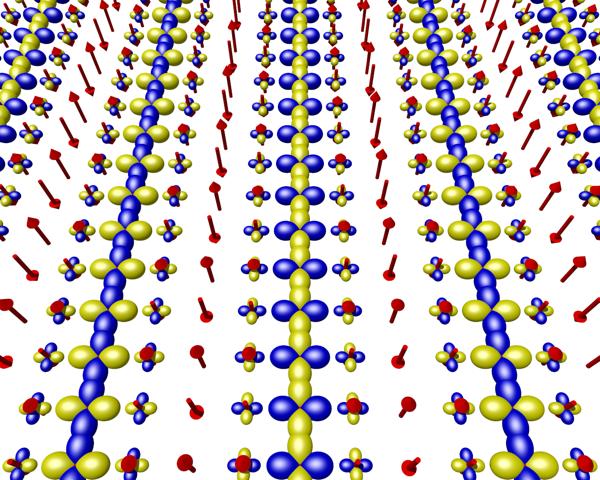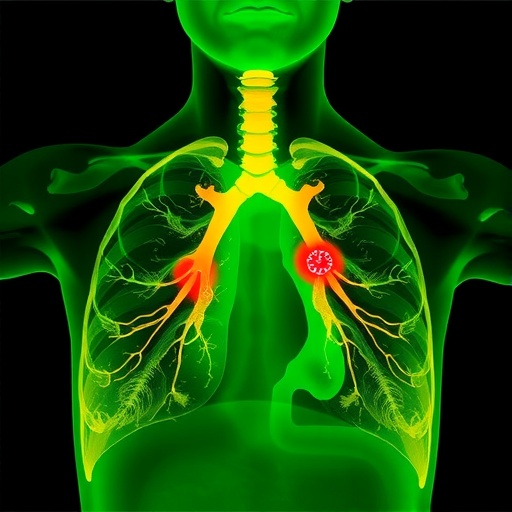New measurements from single electron tunneling provide spectroscopic evidence and cinch the case for a ‘pair density wave’ coexisting with superconductivity

Credit: Brookhaven National Laboratory
UPTON, NY–For years physicists have been trying to decipher the electronic details of high-temperature superconductors. These materials could revolutionize energy transmission and electronics because of their ability to carry electric current with no energy loss when cooled below a certain temperature. Details of “high-Tc” superconductors’ microscopic electronic structure could reveal how different phases (states of matter) compete or interact with superconductivity–a state in which like-charged electrons somehow overcome their repulsion to pair up and flow freely. The ultimate goal is to understand how to make these materials act as superconductors without the need for supercooling.
Now scientists studying high-Tc superconductors at the U.S. Department of Energy’s Brookhaven National Laboratory have definitive evidence for the existence of a state of matter known as a pair density wave–first predicted by theorists some 50 years ago. Their results, published in the journal Nature, show that this phase coexists with superconductivity in a well-known bismuth-based copper-oxide superconductor.
“This is the first direct spectroscopic evidence that the pair density wave exists at zero magnetic field,” said Kazuhiro Fujita, the physicist who led the research at Brookhaven Lab. “We’ve identified that the pair density wave plays an important role in this material. Our results show that these two states of matter–pair density wave and superconductivity–coexist and interact.”
The team’s results come from measurements of single electrons’ tunneling spectra using a state-of-the-art spectroscopic-imaging scanning tunneling microscope (SI-STM) in Brookhaven’s OASIS laboratory.
“What we measure is how many electrons at a given location ‘tunnel’ from the sample surface to the superconducting electrode tip of the SI-STM and vice versa as we vary the energy (voltage) between the sample and the tip,” Fujita said. “With those measurements we can map out the crystalline lattice and the electron density of states–as well as the number of electrons we have at a given location.”
When the material is not superconducting, electrons exist over a continuous spectrum of energies, each propagating at its own unique wavelength. But when the temperature goes down, the electrons start to interact–pairing up as the material enters the superconducting state. When this happens, scientists observe a gap in the energy spectrum, created by an absence of electrons within that particular energy range.
“The energy of the gap is equal to the energy it takes to break the electron pairs apart (which tells you how tightly bound they were),” Fujita said.
As the scientists scanned across the surface of the material, they detected spatially modulating energy gap structures. These modulations in the energy gap revealed that the strength of electrons’ binding varies–increasing to a maximum, then dipping to a minimum–with this pattern repeating every eight atoms across the surface of the regularly arrayed crystal lattice.
This work built on previous measurements showing that the current created by pairs of electrons tunneling into the microscope also varied in the same periodic way. Those modulations in current were the first evidence, though somewhat circumstantial, that the pair density wave was present.
“Modulations in the current of the paired electrons is an indicator that there are modulations in how strongly paired the electrons are across the surface. But this time, by measuring the energy spectrum of individual electrons, we succeeded in directly measuring the modulating gap in the spectra where pairing occurs. The modulations in the size of those gaps is direct spectroscopic evidence that the pair density wave state exists,” Fujita said.
The new results also included evidence of other key signatures of the pair density wave–including defects called “half-vortices”–as well as its interactions with the superconducting phase.
In addition, the energy gap modulations mirror other Brookhaven Lab research indicating the existence of modulating patterns of electronic and magnetic characteristics–sometimes referred to as “stripes”–that also occur with an eight-unit-cell periodicity in certain high-Tc cuprate superconductors.
“Together these findings indicate that the pair density wave plays a significant role in these materials’ superconducting properties. Understanding this state may help us make sense of the complex phase diagram that maps out how superconducting properties emerge under different conditions, including temperature, magnetic field, and charge-carrier density,” Fujita said.
###
Collaborators on this work included Zengyi Du (Brookhaven Lab), Hui Li (Brookhaven Lab and Stony Brook University, Sang Hyun Joo (Seoul National University), Elizabeth Donoway (Brookhaven Lab and University of California, Berkeley), Jinho Lee (Seoul National University), J.C. Seamus Davis (University College Cork, Ireland, and University of Oxford, UK), Genda Gu (Brookhaven Lab), and Peter Johnson (Brookhaven Lab). The work at Brookhaven was supported by the DOE Office of Science and Brookhaven Lab’s Supplemental Undergraduate Research Program. Individual collaborators also received support from the Institute for Basic Science in Korea, the Institute of Applied Physics of Seoul National University, the National Research Foundation of Korea, the Science Foundation of Ireland, and the European Research Council.
Brookhaven National Laboratory is supported by the U.S. Department of Energy’s Office of Science. The Office of Science is the single largest supporter of basic research in the physical sciences in the United States and is working to address some of the most pressing challenges of our time. For more information, visit https:/
Follow @BrookhavenLab on Twitter or find us on Facebook.
One of ten national laboratories overseen and primarily funded by the Office of Science of the U.S. Department of Energy (DOE), Brookhaven National Laboratory conducts research in the physical, biomedical, and environmental sciences, as well as in energy technologies and national security. Brookhaven Lab also builds and operates major scientific facilities available to university, industry and government researchers. Brookhaven is operated and managed for DOE’s Office of Science by Brookhaven Science Associates, a limited-liability company founded by the Research Foundation for the State University of New York on behalf of Stony Brook University, the largest academic user of Laboratory facilities, and Battelle, a nonprofit applied science and technology organization.
Related Links
Scientific paper: “Imaging the Energy Gap Modulations of the Cuprate Pair Density Wave State”
Elusive State of Superconducting Matter Discovered after 50 Years
Electron (or ‘Hole’) Pairs May Survive Effort to Kill Superconductivity
Media contacts: Karen McNulty Walsh, (631) 344-8350, or Peter Genzer, (631) 344-3174
Media Contact
Karen McNulty Walsh
[email protected]
Original Source
https:/
Related Journal Article
http://dx.




